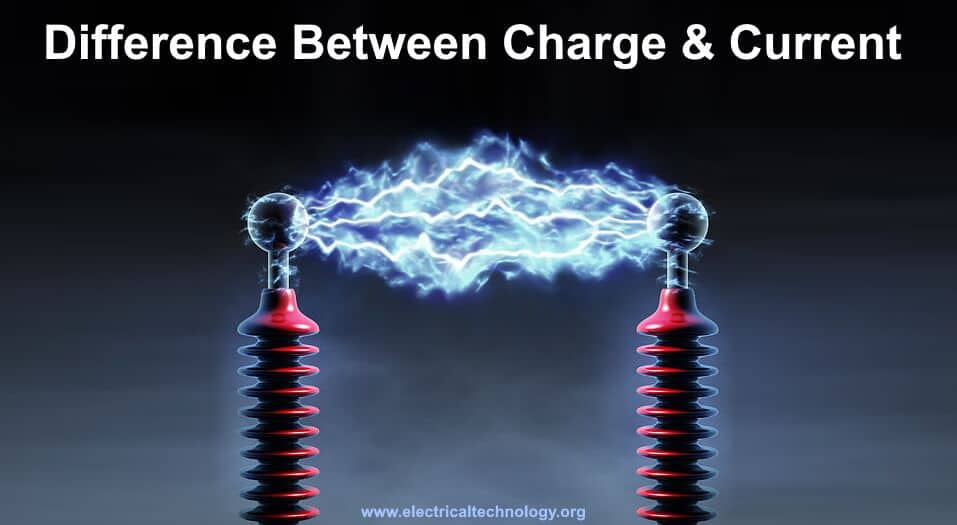Main Difference Between Charge and Current
Electric charge and current are related quantities but they are different from each other.
The main difference between current and charge:
- Current: It is the rate of flow of charge (generally electrons). Current (I) is the physical quantity measured in amperes (A).
- Charge: It is the deficiency or excess of electrons on a body surface. Charge (Q) is the physical property of matter measured in Coulombs (C).
Related Posts:
What is Electric Charge?
The deficiency or excess of electrons on a mater is known is the electric charge. The representative formula of charge is follow:
Q = It … or
Q = en
Where:
- Q = Charge in Coulombs
- I = Current in amperes
- t = time in seconds
- e = number of electrons or proton
- n = charge of one election or proton
The representative symbol of charge is “Q” and measuring unit is Coulomb expressed by “C” where one Coulomb:
- Charge of 6.24 x 1018 electrons = 1C = One Coulomb
or
One Coulomb is the one ampere current per second i.e. The amount of charge which can move by an ampere current from one point to another in one second of time is equal to one coulomb.
or
One Coulomb is the amount of charge when placed in an electric field of one volt per meter (1V/m), then one newton of force will be exerted on it.
- A single electron has -1.602 x 10-19 Coulombs of charge
- A single proton has 1.602 x10-19 Coulombs of charges
Same charges repel each other while unlike charges attract i.e.
- Elections to elections = repulsion
- Protons to protons = repulsion
- Electrons to protons= attraction
The force of attraction or repulsion between two charged particles placed in a distance of “r” can be calculated by Coulomb’s law:
F = K (Q1 Q2 / r2 )
Where:
- F = Force in Newtons
- K = Constant = 8.99×109 m F-1.
- Q1 = First charged particle
- Q2 = Second charged particle
- r = Distance between two charged particles in meters.
There are three types of electric charges.
- Negative Charge: The excess of electrons on the body surface is known as negatively charged mater (excess of electrons which mostly in the lower and outer bands or shell of atom or molecule).
- Positive Charge: The deficiency of electrons on the body surface is called the positively charged mater (excess of protons which mostly in the nucleolus of atoms).
- Neutral = Equal amount of electrons and protons on a particle makes it neutral (Neutrons found in the nucleolus of atom).
Related Posts:
What is Electric Current?
Electric current is the rate of flow of charge (generally electrons) caused by potential difference (voltage). Current is represented by the symbol of “I” and measured in amperes expressed by the symbol of “A”.
When voltage or EMF applied across a conductor, there is a potential difference which moves the vast amount of electrons through it.
Current is a physical quantity which can be measured by the following formula:
I = Q / t … (in Amperes)
Where:
- I = Current in Amperes
- Q = Charge in Coulombs
- t = Time in Seconds
There are two basic types of electric currents i.e.
- AC Current: Flow of charge or elections with changing direction and magnitude.
- DC Current: Flow of charge or elections in one direction with constant magnitude.
Below is the current and charge comparison chart with different characteristics.
Comparison between Electric Charge and Current
The following table shows some differences between charge and current.
| Characteristics | Electric Current | Electric Charge |
| Definition | Current is the rate of flow of charges generally electrons caused by EMF or voltage. | Charge is the property of mater showing the deficiency or excess of electrons on its surface. |
| Symbol | Current represented by the symbol of “I”. | Charge represented by the symbol of “Q”. |
| Unit | SI unit of current is Ampere expressed by “A”. | SI unit of Charge is Coulomb expressed by “C”. |
| Formula | I = Q/t
I = dQ / dt |
Q = It … or
Q = en |
| Force in Fields | Current produces both electric field and magnetic field. | Only produces and rises in electric filed. |
| Movement | Current is the movement and flow of charge generally electrons. | Charge is the movement of electrons i.e. the deficiency or excess of electrons on a body. |
| Measuring instrument | Ammeter (Ampere meter) |
Electrometer or Ballistic Galvanometer |
Related Posts:
- Difference Between Active and Reactive Power
- Difference between Analog and Digital Multimeter
- Difference Between Capacitor and Supercapacitor
- Main Difference between Contactor and Starter
- Difference Between a Battery and a Capacitor
- Main Difference between Fuse and Circuit Breaker
- Basic Electronics Engineering Interview Questions & Answers
- Basic Electrical Engineering Interview Questions and Answers


 Why is the Long Prong Neutral Instead of the Narrow Prong?
Why is the Long Prong Neutral Instead of the Narrow Prong? Why is the Neutral Prong or Slot Wider on a Plug or Outlet?
Why is the Neutral Prong or Slot Wider on a Plug or Outlet? Why are there Grooved Slots in the Pins of Two Pin Plugs?
Why are there Grooved Slots in the Pins of Two Pin Plugs? Difference Between GND, 0VDC, Common and Virtual Ground
Difference Between GND, 0VDC, Common and Virtual Ground Is It Dangerous to Carry a Battery in an Elevator?
Is It Dangerous to Carry a Battery in an Elevator? What is the Difference Between AC Ground and DC Ground?
What is the Difference Between AC Ground and DC Ground?